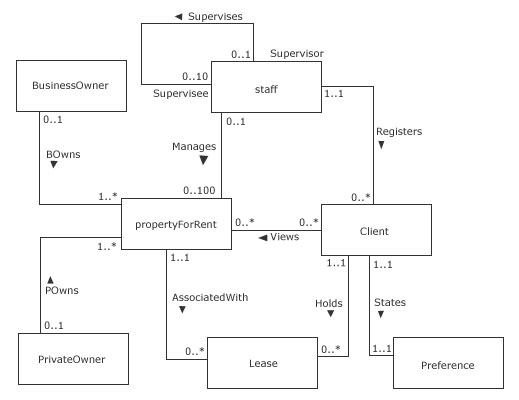08 - Methodology Conceptual Database Design
Objectives
- Purpose of design methodology
- Database design has 3 main phases: conceptual, logical, and physical design
- How to decompose the scope of the design into specific users' views of the enterprise.
- How to use ER modeling to build a local conceptual data model based on information given in a view of the enterprise
- How to validate resultant conceptual model to ensure it is a true and accurate representation of a view of the enterprise
- How to document the process of conceptual database design
Design Methodology
- Structured approach that uses procedures, techniques, tools, and documentation aids to support and facilitate the process of design
- Database design methodology has 3 main phases
- Conceptual database design
- Logical database design
- Physical database design
Conceptual
- Process of constructing a model of information used in an enterprise, independent of all physical considerations.
Logical
- Process of constructing a model of information used in an enterprise based on a specific data model (e.g. relational), but independent of a particular DBMS and other physical considerations.
Physical
- Process of producing a description of the implementation of the database on secondary storage; it describes the base relations, file organizations, and indexes
- Design used to achieve efficicient access to the data, and any associated integrity constraints and security measures
- Where the database is physicaly "built"
Critical Sucess Factors in DB Design
- Work interactively with users as much as possible
- Follow a structured methodology throughout the data modelling process
- Employ a data driven approach.
- Incorporate structural and integrity considerations into the data models.
- Combine conceptualization, normalization, and transaction validation techniques into the data modelling methodology.
- Use diagrams to represent as much of the data models as possible.
- Use a Database Design Language (DBDL) to represent additional data semantics.
- Build a data dictionary to supplement the data model diagrams.
- Be willing to repeat steps.
Conceptual Design
Step 1: Build a local conceptual data model for each user view
- Identify entity types
- Identify the main entity types that are required by the view
- Identify relationship types
-Identify the important relationships that exist between the entity types that have been identified
- identify and associate attributes with entity or relationship types
-Identify and associate attributes with the appropriate entity or relationship types and document the details of each domain
- Determine attribute domains
-Determine domains for the attributes with the appropriate entity or relationship types and document the details of each attribute
- Determine candidate and primary key attributes
-Identify the candidate key(s) for each entity and if there is more than one candidate key, to choose one to be the primary key.
- Consider use of enhanced modelling concepts (optional step)
-Consider the use of enhanced modeling concepts, such as specialization/generalization, aggregation, and composition
- Check model for redundancy
-Check for the presence of any redundancy in the model
- Validate local conceptual model against user transactions
-Ensure that the local conceptual model supports the transactions required by the view
- Review local conceptual data model with user
-Review the local conceptual data model with the user to ensure that the model is a "true" representation fo the user's view of the enterprise
Logical Database Design
Step 2: Build and validate a local logical data model for each view
- Remove features not compatible with the relational model (optional step)
- Derive relations for local logical data model
- Validate relations using normalization
- Validate relations against user transactions
- Define integrity constraints
- Review local logical data model with user
Step 3: Build and validate global logical data model
- Merge local logical data models into global model
- Validate global logical data model
- Check for future growth
- Review global logical data model with users
Physical Database Design
Step 4: Translate global logical data mdel for target DBMS
- Design Base relations
- Design representation of derived data
- Design Enterprise constraints
Step 5: Design physical representation
- Analyze transactions
- Choose file organization
- Choose indexes
- Estimate disk space requirements
Step 6: Design user views
Step 7: Design security mechanisms
Step 8: Consider the introduction of contorolled redundancy
Step 9: Monitor and tune the operational system
Example first cut conceptual ERD




0 Comments:
Post a Comment
<< Home